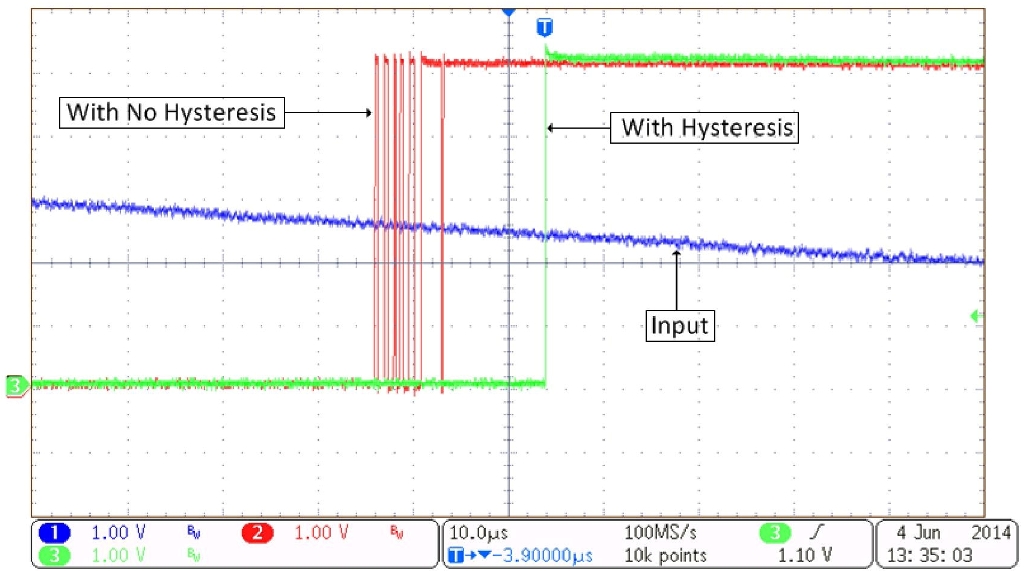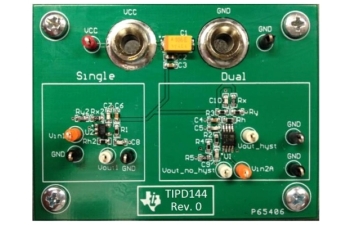Control loops for machines and equipment depend on sensors to accurately monitor real-world and analog conditions. Some measurements are slow to change. For example, a large vat of chemicals that is slowly heated to reaction temperature should experience a predictable and slow change in sensed temperature as the heat is applied. Any rapid and unexpected spike in an adjacent temperature reading could be noise, or, a catastrophic failure. If just one or two samples are erroneous, it is fair to say that some noisy condition or glitch caused a bad sample, and a sufficiently fault-tolerant processor algorithm can easily deal with that.
But, as a threshold of reaction is approached and passed, any subtle noise or variation can cause oscillation of output states (Fig. 1). This can cause an effect similar to the chatter of a mechanical switch. Rapid changes in output can occur. A read of this input will yield erroneous values until the chattering stops.

Fig. 1: Even relatively quiet signals can cause parasitic output oscillations when there is no hysteresis. This can wreak havoc when switching high-power loads. (Source: Texas Instruments)
It is important that a control loop does not react blindly and instantaneously to sample magnitude changes. The averaging of samples in the digital realm can help smooth any of these erroneous changes in value.
Like averaging, hysteresis can be done in the digital domain. A simple “state” register can alert a processor to tell it which threshold to obey as analog values rise or fall. In addition, a sort of digital de-bounce routine can be used to verify that a certain persistence of threshold conditions exists before taking action.
This brings up a couple of interesting points. When and where are digital signal processing most desirable, and when and where does it make sense to conquer anomalies in the analog realm?
The controlled hysteresis function can also be performed discretely and externally to the processor if proper selection of comparators is made.
While virtually all comparators exhibit some hysteresis, some are designed and optimized to take advantage of this hysteresis in the analog domain. This can simplify processor algorithms and improve performance since a processing step is removed.
To aid with these types of designs, many well-engineered and flexible comparators are readily available to meet this need. Take, for example, the Texas Instruments™ family of nanopower open-drain output comparators.
These low-power (470 nano-Amps per channel) comparators are ideal for battery-powered and small-sized handheld designs. Operating from 2.7 to 16 Volts, the inputs are protected from VCC over-voltage up to 5 Volts above VCC. Reverse battery protection (up to 16 Volts) is also built in.
Parts like the TLV3401 in a small 5-pin SOT-23 package contain an individual open-drain comparator, so single-ended sensors can place them as close to the sense point as possible to reduce induced noise. The dual TLV3402 (in a relatively small 8-pin MSOP package) and the 14-pin quad TLV3404 can be used for multiple or differential sensors and feature the same low-power characteristics.
Aiding in the understanding and deployment of this technology is the TIPD144 reference design and test platform (Fig. 2). This design and EVM shows how a comparator with and without hysteresis can function in a specific application.
The reference design discusses the theory of operations, component selection guidelines, simulation results, and modifications to the circuit that can tailor performance to a more specific need.

Fig. 2: A reference design and EVM board can quickly and easily test a sensor’s response with and without hysteresis. (Source: Texas Instruments)
LM331
For more information about this product, click here.
To request a sample, click here.

To buy now at Mouser, click here.
LMV7291
For more information about this product, click here.
To request a sample, click here.

To buy now at Mouser, click here.
TLV1701
For more information about this product, click here.
To request a sample, click here.

To buy now at Mouser, click here.
TLV1702
For more information about this product, click here.
To request a sample, click here.

To buy now at Mouser, click here.
TLV3401
For more information about this product, click here.
To request a sample, click here.

To buy now at Mouser, click here.
TLV3201
For more information about this product, click here.
To request a sample, click here.

To buy now at Mouser, click here.
LM397
For more information about this product, click here.
To request a sample, click here.

To buy now at Mouser, click here.
Author: Jon Gabay, Hearst Business Media
Advertisement
Learn more about Texas Instruments





